The Hollywood Reporter recently published a great article about new discoveries toward a cure for ALS, thanks to contributions and support from Nanci Ryder, veteran talent publicist, and her friends and supporters. Nanci has bravely fought ALS since 2014 and has enlisted the support of such stars as Courteney Cox, Don Diamont, and Renee Zellweger.
“Team Nanci” has raised over $580,000 for The ALS Association through Walk to Defeat ALS events. (Kathy Shawver Maffei, a leader for Team Nanci, is a newly elected member of the board for The ALS Association Golden West Chapter.)
The Hollywood Reporter article by Dr. Justin Ichida – as told to Chris Gardner, a The Hollywood Reporter staff writer – describes the discoveries (and some of the science behind them) and credits not only Ryder’s fundraising and awareness efforts but also federal funding from the Department of Defense’s (DoD) ALS Research Program (ALSRP) for making his research possible.
Under the leadership of Dr. Lucie Brujin, MBA, chair emeritus of the ALSRP, and chief scientist for The ALS Association, the ALSRP “specifically supports innovative preclinical research targeting development of new therapeutics for ALS.” The ALS Association, with help from more than 16,000 ALS advocates across the U.S., is proud to lobby for this and other government funding for ALS and related research.
Dr. Ichida is an assistant professor of Stem Cell Biology and Regenerative Medicine at the University of Southern California (USC) in Los Angeles, Calif., and a New York Stem Cell Foundation-Robertson Investigator. (We featured him in an article here on our blog last year.)
In a study published this month in the prestigious journal Nature, Dr. Ichida and colleagues set out to better understand the underlying pathway behind the C9orf72 gene expansion, which is the most common cause of familial (inherited) and sporadic (non-inherited) ALS and Frontotemporal dementia.
Past studies have debated whether the C9 expansion causes motor neuron toxicity by either loss of the normal C9 protein or the accumulation of aggregated (clumped) proteins. Here, researchers notably found that both pathways cause toxicity.
Importantly, Dr. Ichida and colleagues carried out a compound screen – 800 compounds tested – to uncover a compound that improves C9 motor neuron survival. From the screen, they identified an inhibitor compound that rescued C9 motor neurons derived from people living with ALS in a dose-dependent manner.
Dr. Ichida told The Hollywood Reporter, “We have made a major discovery in our search to find a cure for ALS. […] We have used stem cell technology to create nerve cells in a Petri dish from an actual ALS patient. [….] Instead of extracting nerve cells, we took blood cells and converted them to nerve cells by going through a stem cell intermediate. In that way, we can make real nerve cells from an ALS patient in a lab. By doing that, the cells can recapitulate all of the things we can see in a patient, and it becomes a platform for studying ALS.”
He added, “We found out how ALS is causing the nerve cells to degenerate, and by doing that we were able to find a new protein target. With this new target, we can use a drug to bind to it that we think can change the disease course for ALS patients. The next step is to try to get the drug into clinical testing, but first, we need to make this chemical more stable for the body. We have launched a startup company that is hopeful that they can change the structure of the chemical to last longer in the human body and make it more drug-like. A similar drug has already been in clinical trials for use to treat Crohn’s disease so we know that this approach is safe, which might make it easier to go through the phases, which still could take years. [….] I'm hopeful.”
Click here to read The Hollywood Reporter article, titled “How Nanci Ryder's ALS Fight Sparked a Medical Breakthrough.”
For a more detailed look at the Nature paper, click here.
Paper citation
Shi Y, Lin S, Staats KA, Li Y, Chang WH, Hung ST, Hendricks E, Linares GR, Wang Y, Son EY, Wen X, Kisler K, Wilkinson B, Menendez L, Sugawara T, Woolwine P, Huang M, Cowan MJ, Ge B, Koutsodendris N, Sandor KP, Komberg J, Vangoor VR, Senthilkumar K, Hennes V, Seah C, Nelson AR, Cheng TY, Lee SJ, August PR, Chen JA, Wisniewski N, Hanson-Smith V, Belgard TG, Zhang A, Coba M, Grunseich C, Ward ME, van den Berg LH, Pasterkamp RJ, Trotti D, Zlokovic BV, Ichida JK. Haploinsufficiency leads to neurodegeneration in C9ORF72 ALS/FTD human induced motor neurons. Nat Med. 2018 Feb 5; PubMed.


Join the conversation. Please comment below.